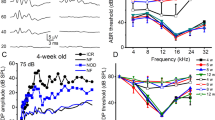Summary
We examined the cochleae of the spontaneously diabetic KK mice by using transmission electron microscopy. At the age of 3 months, the mice started to show evidence for glycosuria and hyperglycemia, and tissue sections showed beginning cochlear pathology. The pathological changes present were found to be limited to the stria vascularis: protrusions of marginal cells, swellings of intermediate cells and widening of intercellular spaces were the main findings seen. These changes progressed with age, but were not observed in age-matched nondiabetic 57BL/6 mice. The possible mechanism of diabetes causing cochlear pathology is discussed.
Similar content being viewed by others
References
Axelsson A, Sigroth K, Vertes D (1978) Hearing in diabetes. Acta Otolaryngol [Suppl] 356:1–23
Costa OA (1967) Inner ear pathology in experimental diabetes. Laryngoscope 77:68–75
Ditzel J (1980) Problem of tissue oxygenation in diabetes as related to development of diabetic retiopathy. In: Mausolf FA (ed) The eye and systemic disease, 2nd edn. Mosby, St. Louis, pp 170–186
Duvall AJ, Santi PA, Hukee MJ (1980) Cochlear fluid balance: a clinical/research overview. Ann Otol Rhinol Laryngol 89:335–341
Gladney JH (1978) Experimental diabetes and the inner ear. A proposed biological model. Ann Otol Rhinol Laryngol 87:128–134
Jorgensen MB (1961) The inner ear in diabetes mellitus. Arch Otolaryngol [Suppl] 188:125–128
Jorgensen MB (1962) Changes of aging in the inner ear, and inner ear in diabetes mellitus. Histological studies. Acta Otolaryngol (Stockh) [Suppl] 188:125–128
Kinoshita JH (1974) Mechanism of cataract formation. Invest Ophthalmol 13:713–724
Kondo K, Nozawa K, Tomita T, Ezaki K (1957) Inbred strains resulting from Japanese mice. Bull Exp Animals 6:107–112
Konishi T, Kelsey E, Singleton GT (1967) Early stage of anoxia. Acta Otolaryngol (Stockh) 62:393–404
Kovar M (1973) The inner ear in diabetes mellitus. ORL 35:42–51
Makishima K, Tanaka K (1971) Pathological changes of the inner ear and central auditory pathway in diabetics. Ann Otol 80:218–229
Marshak G (1972) The inner ear in experimental diabetes mellitus. Acta Otolaryngol (Stockh) 300:1–18
Nakamura M (1962) A diabetic strain of mouse. Proc Jpn Acad 38:348–352
Thalmann R, Kusakari J, Miyoshi T (1973) Dysfunctions of energy releasing and consuming process of the cochlea. Laryngoscope 83:1690–1712
Author information
Authors and Affiliations
Rights and permissions
About this article
Cite this article
Tachibana, M., Nakae, S. The cochlea of the spontaneously diabetic mouse. Arch Otorhinolaryngol 243, 238–241 (1986). https://doi.org/10.1007/BF00464437
Received:
Accepted:
Issue Date:
DOI: https://doi.org/10.1007/BF00464437




